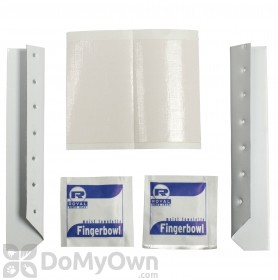Centipedes in the house can be a startling sight. With their feathery appearance and lightening quick speeds, they can easily send a fright through anyone. However, these pests are mostly harmless and can provide some pest-control friendly benefits as they hunt for their food - other pests - in your home.
However, if you prefer to not have these "hundred-legged worms" greeting you when you turn on the lights in the bathroom, follow the below steps to make your home less inviting for these pests.
Eliminate House Centipede Food Sources

Centipedes feed on other insects and small pests, and they often enter homes in search of a meal. By eliminating the other pests in your home, you can immediately make your home less welcoming to house centipedes.
Apply a preventative pest control treatment around your home every 30-90 days with a general concentrated insecticide. Spray around the foundation, where cables and pipes enter the home, around door and window frames, and around vents and soffits. Use sticky glue traps in your home so that you can track what pests are inside and when the population begins to increase again.
The DoMyOwn Pest Box is a subscription program that takes the guesswork out of your preventative pest control by customizing a program for your home and delivering it to your door when you need it.
Reduce Moisture Problems In and Around Your Home
Centipedes live in cool and damp locations in the home. By repairing any leaks and reducing the humidity, you can help control the population of centipedes in your house.
- Find and fix any leaky faucets and pipes.
- Dry up wet or damp areas where centipedes thrive.
- Fix any cracks and crevices in the foundations or slab that allow moisture to enter the home.
- Use a dehumidifier inside your home to reduce the humidity.
- Use fans, open doors and window when weather permits to allow air circulation inside the home.
- Water your lawn and landscaping in the morning so that it can dry by the afternoon.
- Do not over mulch flower beds. Soggy mulch is an ideal hiding place (harborage) for centipedes.
Keep House Centipedes from Getting in Your Home

Centipedes can enter your home through very small openings. Sealing cracks and filling gaps can help keep these long bugs with lots of legs out of your home.
- Make sure window screens, door sweeps, and weather stripping are fully intact.
- Seal any cracks, crevices, or gaps in your structure with copper mesh, Xcluder cloth, expanding foam or caulk.
- Replace or repair broken or missing vent covers.
- Find and seal up any cracks or crevices with caulk. This includes around windows, doors, pipes, and wires.
- Close any openings where they can get in around pipes and wires using copper mesh.
- Make sure screens and door sweeps on windows and doors are tight-fitting.







